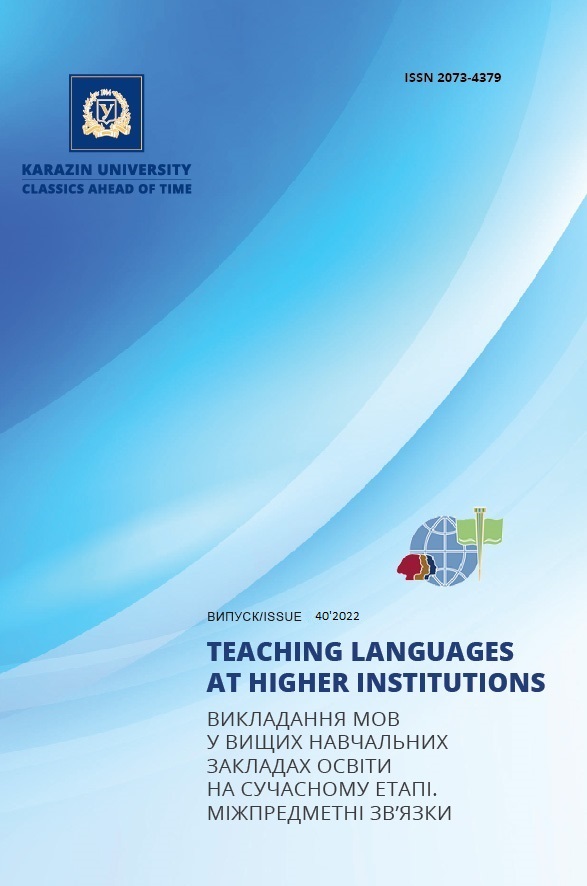Proper names of arab applicants of higher education: structure features and functioning specificity within the university education space
Abstract
The article deals with the analysis of the structure and functioning of the proper names of Arab educational migrants. The authors have identified and described the general features of the construction of Arab anthroponyms and the problems of intercultural communication. The object of this scientific research is the official proper names that are presented in the passports of Arab applicants for the higher education of V.N. Karazin Kharkiv National University and the functioning of these names in educational, pedagogical, and official business discourse. For this research, it was chosen to compare and analyze the structures of proper names of students from different Arab countries. The number of Arab students is about 20 percent of the total number of educational migrants at the university. The authors also describe the differences between the proper names of Arab students and the official Ukrainian formula. They analyze current studies of the peculiarities of naming traditions, the origin of ethnic anthroponyms, and the peculiarities of the structure and processes of change in modern anthroponyms of different languages. Changing a country of residence causes problems of inconsistency between the official models of the full name of the educational migrant and the corresponding model of the host country. This leads to some problems with intercultural communication among dean’s staff, teachers, and the educational migrants themselves. The article presents examples of name translation in various documents issued by host countries. The authors highlight the differences in the regulations of migrants from Arab countries in comparison with Ukrainian norms: the order of succession, the lack of names, surnames, patronymics, and matronymics. The authors also set tasks for ethnic communicators who expand the professional competencies of the lecturer on the peculiarities of the use of Arabic anthroponyms. The authors conclude by suggesting prospects for further investigation of this problem. The lecturer’s task is to consistently promote the complex process of linguistic and socio-cultural adaptation of Arab educational migrants.
Downloads
References
Vostriakova, N.A. (2015). Proper names at the elementary level of training to Russian as a foreign language (problems of adequate semantization and use). Vestnik SMOM, Filologiya. Kulturologiya. Metodika [Bulletin of the center for international education of the Moscow state university. Philology. Culturology. Pedagogy. Methodology], 1, pp. 36–41 [in Russian].
Dmitrieva, D.D. (2018). Linguistic-cultural analysis of proper name in the address function on lessons of Russian as foreign. Karelian Scientific Journal. Pedagogical sciences. Vol. 7, 3 (24), pp. 9–12 [in Russian].
Kuplevatska, L.O. and Manivska, T.E. (2020). Linguocommunicative competence of the linguist teacher: ethnospecificity of anthroponyms’ functioning in the learning and pedagogical discourse of the educational space. Teaching languages at higher educational establishments at the present stage. Intersubject relations. Kharkiv: V.N. Karazin Kharkiv National University, 36, pp. 111–130 [in Ukrainian]. DOI: https://doi.org/10.26565 /2073 -4379-2020-36-09.
Kuplevatska, L.O. and Manivska, T.E. (2021). Problems of functioning of modern Arabic anthroponyms in the framework of intercultural communication of the Ukrainian educational space. Teaching languages at higher educational establishments at the present stage. Intersubject relations. Kharkiv: V.N. Karazin Kharkiv National University, 38, pp. 153–169 [in Ukrainian]. DOI: https://doi.org/10.26565/2073-4379-2021-38-11.
Liga arabskykh derzhav [Ligue of Arabic states]. (2021). Availiable at: https://mfa.gov.ua/mizhnarodni-vidnosini/liga-arabskih-derzhav [Accessed 21 Feb. 2022] [in Ukrainian].
Tavtysheva, F.Z. Osobennosti upotrebleniia obrashchenii v arabskom yazyke [Peculiatrities of Addressing in the Arabic language]. Availiable at: https://upload.pgu.ru/iblock/7c3/uch_2012_x_00013.pdf [Accessed 21 Feb. 2022] [in Russian].
Maha, Oden. (2019). How do Arabic names work? 5 answers. Availiable at: https://www.quora.com/What-is-the-Arabic-variant-of-Michael-how-common-is-this-name [Accessed 21 Feb. 2022] [in English].

